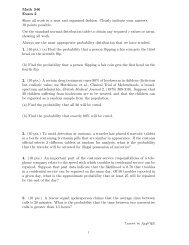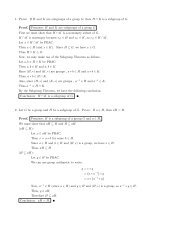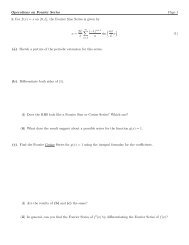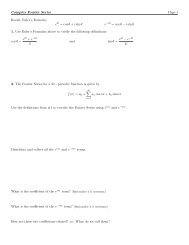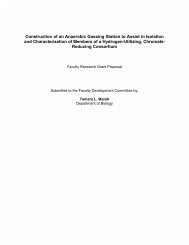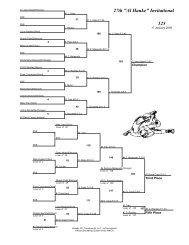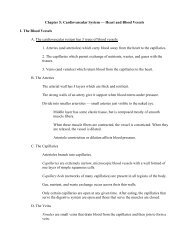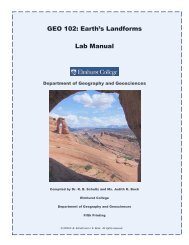Free Executive Summary - Elmhurst College
Free Executive Summary - Elmhurst College
Free Executive Summary - Elmhurst College
Create successful ePaper yourself
Turn your PDF publications into a flip-book with our unique Google optimized e-Paper software.
Learning to Think Spatially: GIS as a Support System in the K-12 Curriculum<br />
http://www.nap.edu/catalog/11019.html<br />
SPATIAL THINKING IN EVERYDAY LIFE, AT WORK, AND IN SCIENCE 57<br />
the universe. This is the process by which generations of astronomers have attempted to infer the<br />
structure and evolution of the universe from the basic observations, the spatial primitives of astronomy.<br />
They did so by converting data about energy into representations, often graphic, that<br />
allowed them to draw inferences about the physics of the stars and the cosmos. Spatial thinking is<br />
so pervasive in astronomy that in our illustrative story, we will further restrict the discussion to<br />
some of the key steps that built up a cosmic distance scale and enabled us to place objects in space,<br />
and eventually in time, with increasing precision.<br />
3.5.3 The First Step: The Shape and Size of Earth<br />
The first step in the process involved inferences about the shape and size of Earth. Central to<br />
this process were the attempts to measure the size of Earth and, outstanding among those attempts,<br />
was the work of Eratosthenes.<br />
Of the remarkable series of polymaths who were librarians of the Great Library in Alexandria,<br />
Egypt, none was more remarkable than Eratosthenes of Cyrene (275–194 BC) (see Casson, 2001).<br />
Eratosthenes was, among other things, a mathematician, a philosopher, and a geographer. In the last<br />
of these avocations, he was a pioneer. He produced a remarkably accurate world map, centered on<br />
the “known” world of the Mediterranean Sea. The map was the first to include parallel lines of<br />
latitude. He suggested that Africa might be circumnavigated and that the major seas were connected.<br />
He calculated the length of the year and proposed adding a leap year to accommodate for the<br />
progressive discrepancy between Earth’s orbit and the calendar.<br />
Of his geographic achievements, Eratosthenes is best remembered for his work in geodesy,<br />
establishing the scientific grounding for that discipline through a brilliant exercise in spatial thinking.<br />
He calculated the circumference of Earth:<br />
He did this by employing a method that was perfectly sound in principle: first ascertaining by<br />
astronomical observations the difference between the latitudes of two stations situated on the same<br />
meridian, also by terrestrially measuring the distance between the same two stations, and finally, on<br />
the assumption that the earth was spherical in shape, by computing its circumference. (Vrettos,<br />
2002, p. 52)<br />
The details of the actual procedure are even more remarkable. It combined knowledge, observation,<br />
calculation, inference, and intuition in a way that captures the essence of spatial thinking.<br />
Eratosthenes was aware of the idea, which had been proposed by earlier Greek natural philosophers,<br />
that Earth is spherical in shape. When he learned from travelers that at noon on the summer<br />
solstice in Syene (modern Aswan) the Sun shone directly into a deep well and its reflection was<br />
visible on the surface of the water in the well, he realized that the Sun must be directly overhead at<br />
that date and time, so that a gnomon (vertical stick) would cast no shadow. If Earth is indeed<br />
spherical, on the same date and time, a gnomon where he lived, in Alexandria, would cast a shadow.<br />
A smaller Earth, with a greater curvature, would produce a longer shadow than a larger Earth.<br />
He realized that this general argument could be turned into a quantitative measurement by<br />
envisioning a frame of reference with an origin at the center of Earth, and by assuming that the Sun<br />
is so far away that its rays would be nearly parallel at Syene and Alexandria (Figure 3.2). In that<br />
case, the angle formed by a gnomon and the tip of its shadow in Alexandria, would be the same<br />
angular distance between Syene and Alexandria that would be observed from the center of Earth.<br />
He measured this angle and found it to be 7 degrees and 12 minutes, or approximately 1/50th of a<br />
circle. Since the overland distance between Alexandria and Syene had been measured by travelers<br />
(5,000 stade), he multiplied that number by 50 to arrive at a distance for the circumference of Earth.<br />
Starting from the generally accepted belief that Alexandria and Syene (modern Aswan) were<br />
on the same meridian and his belief that Earth was spherical, Eratosthenes used a frame of reference<br />
Copyright © National Academy of Sciences. All rights reserved.



